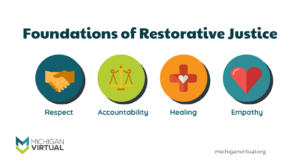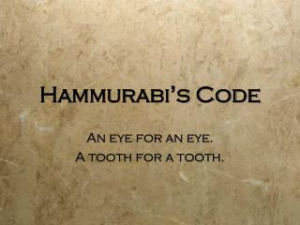Justifications of Punishment
Garrett Catanese; Aidan Ceci; Jacob Guarino; and Morgan McLaughlin
Restorative justice is a type of remedy for the aftermath of a crime being committed. Restorative justice is a type of rehabilitation for inmates to repair the community or families their crimes have impacted. This type of treatment is very effective in the fact it attempts to heal the damage the offender has done. It consists of the offender doing some good to try and heal the person they hurt or the people such as family members. The United States has started to use this tool in recent times but the most common example you see is when someone is caught speeding and endangering the public and they are served community service hours to give back to the community.
 Deterrence is the reduction of offending through the sanction or threat of sanction. There are two categories that deterrence is split into, specific deterrence and general deterrence. The difference between the two is that special deterrence is geared towards teaching offenders a lesson so that one particular offender doesn’t commit another crime. While the general deterrence purpose is to prevent crime among the entire general population. Marginal, absolute and displacement are the sub-principles of deterrence. Each is its own way of deterring crime. Marginal deterrence is based on the crime that is reduced in amounts by the offender. Absolute is point blank having the police force removing crime as a whole, which has been proven to not be effective. Displacement has been argued that crime cannot be removed but rather shifted into three levels, time, location and the type of crime that has been committed. In order for any principle of deterrence to work, all of those who are involved must have a general concept of the level of punishment they will receive and or give.
Deterrence is the reduction of offending through the sanction or threat of sanction. There are two categories that deterrence is split into, specific deterrence and general deterrence. The difference between the two is that special deterrence is geared towards teaching offenders a lesson so that one particular offender doesn’t commit another crime. While the general deterrence purpose is to prevent crime among the entire general population. Marginal, absolute and displacement are the sub-principles of deterrence. Each is its own way of deterring crime. Marginal deterrence is based on the crime that is reduced in amounts by the offender. Absolute is point blank having the police force removing crime as a whole, which has been proven to not be effective. Displacement has been argued that crime cannot be removed but rather shifted into three levels, time, location and the type of crime that has been committed. In order for any principle of deterrence to work, all of those who are involved must have a general concept of the level of punishment they will receive and or give.
Rehabilitation is a way to reduce recidivism once ex-offenders are released back into society. Rehabilitation attempts to address the three goals of corrections: punish the offender, protect society, and rehabilitate the offender. In-prison and jail rehabilitation programs such as academic education, career technical education, and cognitive behavioral therapy can improve the likelihood of offenders living a productive and crime free life upon their release from incarceration. Criminal risk factors that are associated with criminal thinking can be addressed by the rehabilitation programs. In many cases, cognitive behavioral change can be successful in helping inmates understand criminal wrongdoing and the consequences of breaking the law.
 Retribution is when the criminal justice system wants to make sure the offender is receiving a punishment that is proportional to the seriousness of the crime that the offender committed. Every offender who commits the same crime will receive the same type of punishment, regardless of the differences between offenders. Retribution does not discuss the future harm that could occur, it only looks at the past harm that was created by the crime. One of the earliest forms of retribution was the Hammurabi Code. The law that the code had that is similar to retribution is an “eye for an eye”. This means that if someone were to commit a crime, they would get a punishment that would be equal to the crime.
Retribution is when the criminal justice system wants to make sure the offender is receiving a punishment that is proportional to the seriousness of the crime that the offender committed. Every offender who commits the same crime will receive the same type of punishment, regardless of the differences between offenders. Retribution does not discuss the future harm that could occur, it only looks at the past harm that was created by the crime. One of the earliest forms of retribution was the Hammurabi Code. The law that the code had that is similar to retribution is an “eye for an eye”. This means that if someone were to commit a crime, they would get a punishment that would be equal to the crime.
Incapacitation is when an individual who committed a crime is removed from society so they cannot commit more crimes and negatively affect the community. An example from history are hulk ships. These were large ships that took those that committed crimes away from their home community so they cannot harm their community. More recently, politicians have been using incapacitation as a way to push their political agenda. During the 1990s, the United States was in the “tough on crime” era. In order for the politicians to win the election, they would say they are in favor of longer prison sentences, and the citizens who agreed with a longer time of incarceration would vote for them. Soon after, this caused a major growth in the population in prison. There was not much of a worry to send those who were incarcerated for lesser crimes to specialized programs to help them.
agenda. During the 1990s, the United States was in the “tough on crime” era. In order for the politicians to win the election, they would say they are in favor of longer prison sentences, and the citizens who agreed with a longer time of incarceration would vote for them. Soon after, this caused a major growth in the population in prison. There was not much of a worry to send those who were incarcerated for lesser crimes to specialized programs to help them.
Reintegration is when there are programs that are attempting to help them develop skills that they will be able to use when they leave jail or prison. Some examples of programs that are used to help reintegrate are educational programs, vocational programs, and substance abuse programs. The educational programs are used to assist the incarcerated individuals in receiving some sort of education that they can use to find a job when they are no longer incarcerated. Vocational programs are used to help the incarcerated develop some sort of skill in a trade that they can use as another way to make an income. Substance abuse programs are beneficial for the incarcerated because if they can find other ways to cope with stress instead of doing drugs or drinking alcohol, they will start to become healthier and will not spend money on those things.
In the video, 5 Incredible Prison Rehabilitation Programs,, it gives a different perspective of unusual rehabilitation programs that are helping prisoners cope and are realigning their cognitive behavior while in prison. These programs offer prisoners a chance to change their mentality about life. The video shows prisoners engaging in a variety of programs that involve an animal farm, a financial education class, horse training, acting, and the art form Butoh. The benefits that these programs can offer are emotional, educational, and job training. Prisoners find enjoyment, excitement, and passion in these rehabilitation programs, which helps provide them with hope and a way to channel themselves to become better citizens, instead of continuing the criminal mindset while incarcerated.
Critical Thinking Questions/Exercise
Watch any movie about life inside of a prison. Keep track of what rehabilitation programs there are in the prison versus the amount of punishments the prisoners receive for something they should be participating in a rehabilitation program for.
- Are there enough rehabilitation programs?
- Are the punishments they are given proportional to the rule they broke?
References
Carter, D. (n.d.). 8.3. deterrence. SOUCCJ230 Introduction to the American Criminal Justice System. from https://openoregon.pressbooks.pub/ccj230/chapter/8-3-deterrence/
Carter, D. (n.d.). 8.4. incapacitation. SOUCCJ230 Introduction to the American Criminal Justice System. from https://openoregon.pressbooks.pub/ccj230/chapter/8-4-incapacitation/
Carter, D. (n.d.). 8.5. rehabilitation. SOUCCJ230 Introduction to the American Criminal Justice System, from https://openoregon.pressbooks.pub/ccj230/chapter/8-5-rehabilitation/
Carter, D. (n.d.). 9.10. restorative justice. SOUCCJ230 Introduction to the American Criminal Justice System. from https://openoregon.pressbooks.pub/ccj230/chapter/9-10-restorative-justice/
Carter, D. (n.d.). 8.2. retribution. SOUCCJ230 Introduction to the American Criminal Justice System. from https://openoregon.pressbooks.pub/ccj230/chapter/9-2-retribution/
YouTube. (2019, November 11). 5 incredible prison rehabilitation programs. YouTube. from https://www.youtube.com/watch?v=XmqL65ZBx44Move to Trash
Taylor, M. (2017). Improving in-prison rehabilitation programs. Legislative Analyst’s Office LAO.
